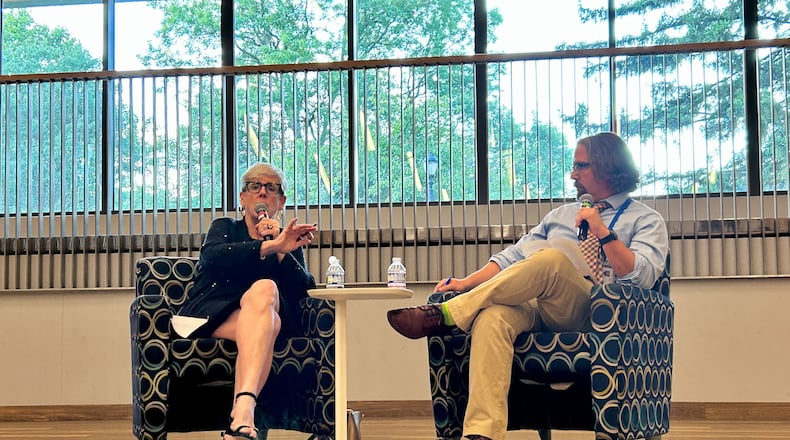O’Connor has spearheaded the redistricting reform effort after retiring in 2022 as chief justice of the Ohio Supreme Court.
On seven occasions, O’Connor’s court ruled that the current, politician-led system drew congressional and legislative maps that were unconstitutional — a fact that she said made it clear the state needed politicians out of the process altogether.
“It is an innate conflict of interest. They can’t help themselves,” said O’Connor to a crowd of about 170 people at the Dayton Metro Library downtown branch on Tuesday. “Whether they’re Ds or Rs, they can’t help themselves to retain power, to expand power, to do what is best for party over citizens, and that’s exactly what we’ve seen.”
O’Connor is the face of the Citizens Not Politicians campaign backing the effort. There is no formal opposition group, but the proposal is staunchly opposed by Republican statewide officeholders, many of whom have a part in current politician-led redistricting panel.
For Gov. Mike DeWine, getting politicians out of redistricting is a good idea, but he doesn’t believe Issue 1 is the right solution. He’s explained that, like the current system, Issue 1 places too much of an emphasis on “proportionality” — the idea that the sum of Ohio’s legislative districts ought to reflect the political leanings of Ohio’s electorate — which he believes will force the map drawers to take on too many political considerations, whether they’re politicians or not.
Other Republicans have called out the proposal’s out-of-state financial backing, or have called into question how accountable an unelected citizen panel can be to the public, or have characterized the proposal as a crutch for Democrats who they say are outnumbered in the Ohio legislature due to voter preference, not foul play.
Ohio Secretary of State Frank LaRose recently approved ballot language that said Issue 1 would actually require, not ban, gerrymandering, among other things. Such claims are being challenged in court by Citizens Not Politicians.
The Dayton Daily News solicited questions from readers about the proposed amendment and posed several to O’Connor at the library event, including the concerns raised by critics. Here are answers to some of those questions.
How would Issue 1 work?
Issue 1, if approved by a simple majority of voters on Nov. 5, would completely scrap the state’s current redistricting system (installed in patchwork fashion by two citizen votes in the past decade) and replace it with a new system of rules and protections that, in all, are not too dissimilar to what’s already in place, according to the text of the amendment.
For example, both the current system and Issue 1 place an emphasis on proportionality. While the current system looks at voting data over the past 10 years to roughly determine Ohioans’ partisan leanings, Issue 1 would look at the past six years. And, while the current system requires that the sum of the maps “correspond(s) closely” with the partisan lean of the state, Issue 1 defines that the maps should be within 3%, if possible.
Both systems require districts to be contiguous and both require map drawers to consider communities of interest.
The biggest change Issue 1 would bring is in who draws the maps.
Under the current system, seven politicians — the governor, the auditor, the secretary of state, two Democrats and two Republicans from the legislature — are granted the power of the pen. This system has been called into action twice, each time having a partisan lean of five Republicans and two Democrats, and consensus has been hard to come by.
Issue 1 would dissolve that panel and replace it with a 15-member citizen commission meant to be free from political imbalance and personal stakes. The commission would consist of five Republicans, five Democrats and five voters not affiliated with either major party.
How would the new map drawers be picked?
The most common question submitted to to the Dayton Daily News asked how the 15-member commission would be selected. It’s a complicated process.
First, two members from each party on the Ohio Ballot Board would each select two retired judges, creating a four member “bipartisan screening panel.”
That panel would field applications from Ohioans interested in becoming commissioners.
Many Ohioans would be automatically disqualified from serving on the commission based on their personal relationships or political activity.
The proposal says commissioners could not have any employment or contracts or “other involvement” with elected officials or candidates for office, or any contractual relationships or involvement with political parties, ballot measure campaigns, or political action committees. Public employees such as teachers, public university professors or police officers would not be exempt from participating due to their occupation alone.
The four-judge panel would narrow down applications to a list of 90 qualified people — 30 Republicans, 30 Democrats and 30 others (which could theoretically consist of green party voters, libertarians or other third parties) — which would be made public. Those individuals would then be vetted by an outside contractor and interviewed, with the interviews being made public.
With help from public input, the screening panel would then whittle the list down to 45 finalists, 15 from each ideological pool and all from a “geographically and demographically representative cross-section of Ohio.”
Soon thereafter, the panel would randomly draw two Republicans, two Democrats and two from neither major party to serve as commissioners. Those six commissioners would then select nine individuals from the remaining pool of finalists to fill out the 15 member board.
What rules would they have to follow?
The first rule regarding the commission, if passed, is the timeline. Issue 1 says says the panel must start in 2025 to create maps for the 2026 primary election. After that, the commission would be convened once following each publication of the U.S. Census, which occurs at the start of every decade.
Approved maps would be good for the remainder of that decade, under the plan. An approval of any map would require an affirmative vote of at least nine members, including at least two members from each ideological pool, theoretically preventing one party from steamrolling the others.
The citizen panel would be required to hold at least 10 meetings across the state throughout the process, with two meetings each occurring in southwest Ohio, southeast Ohio, northeast Ohio, northwest Ohio and central Ohio — an idea similar to the current process, but considerably more fleshed out.
In terms of map drawing, here are the rules:
• All maps must comply with United States Constitution, the Voting Rights Act of 1965 and all other applicable federal laws.
• Partisan gerrymandering is banned, as is “the use of redistricting plans that favor one political party and disfavor others.”
• Commissioners must also “comply, to the extent possible,” with the following rules: Like districts must have relatively similar populations; districts must “ensure the equal functional ability of politically cohesive and geographically proximate racial, ethnic, and language minorities to participate in the political process and to elect candidates of choice;” and districts need to preserve communities of interest to the extent practicable.
• On proportionality, Issue 1 says: “The statewide proportion of districts in each redistricting plan that favors each political party shall correspond closely to the statewide partisan preferences of the voters of Ohio.” The amendment would allow deviation up to 3%, but notes that in cases where 3% and under is impossible, commissioners must pick the map with the smallest difference.
Republicans, such as secretary LaRose, have argued that any requirement to make the maps skew a certain way inherently promotes gerrymandering, given that the common definition of the term is the manipulation of political boundaries in order to favor a particular party. O’Connor has countered that the emphasis on proportionality has been overstated.
“It’s been overly emphasized that it’s going to be a political driving force in order to get a certain ratio, but that’s not the way it works, that’s not how it’s going to be,” said O’Connor, who argued that the amendment equally weights proportionality with other considerations and mandates the commission to pick the most proportional map so long as it meets other standards.
Can members get kicked off the commission?
According to the proposal, commission members can only be removed from the commission by their peers. A vote for removal must be preceded by a notice, a public hearing, and an opportunity for the public to weigh in.
Causes for removal include: Failure to disclose relevant information about themselves; willful disregard for the proposal’s map drawing rules; wanton and willful neglect of duty; incapacity or inability to perform their duties; and “behavior involving moral turpitude or other acts that undermine the public’s trust.”
Who would pay for the commission?
Under Issue 1, the commission would be paid for by public tax dollars, as is the current commission. Issue 1 requires $7 million for the 2025 redistricting cycle, which O’Connor said is the same amount of money spent by the current redistricting commission for the 2020 redistricting cycle.
Commissioners would be paid $125 per day and would be reimbursed for reasonable costs involved with the job. Other notable costs involve the contracting of private search and screening firms, legal experts and litigation, if called for.
Who’s paying for the campaign?
Early campaign finance reports show that 84.3% of the more than $23 million raised by Citizens Not Politicians has come from out-of-state donors. The overwhelming majority of those funds have come from progressive dark money groups, such as the Sixteen Thirty Fund, which has drawn consternation from Republican opponents.
O’Connor rebuffed those concerns Tuesday by saying, “The concern for democracy doesn’t stop at the border of Ohio.”
“Any organization in this country that is concerned with democracy being fair, with our government being elected for the people, by the people, and wants to fight gerrymandering, I’ve got no problem with what they contribute — absolutely none,” O’Connor continued. “No Ohioan should.”
About the Author

